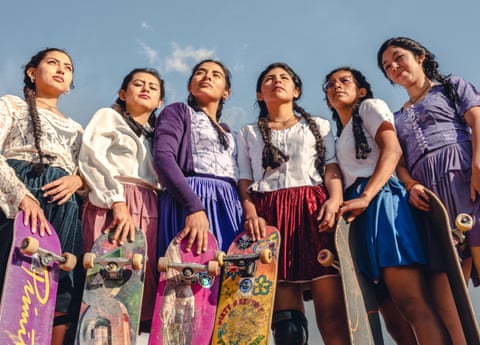The Bolivian “polleras”, bulky skirts commonly associated with the indigenous women from the highlands, were for decades a symbol of uniqueness but also an object of discrimination. Now, a new generation of women skateboarders in Cochabamba, the country’s third largest city, wear them as a piece of resistance. The voluminous attire has its origins in the Spanish conquest, in the 16th century. It was imposed on the native population, but through the subsequent centuries the garment became part of the local identity.
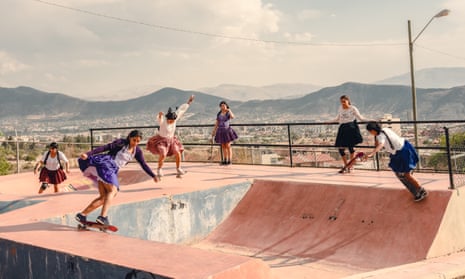
Since it symbolises authenticity and stigmatisation, dusting off the polleras that once belonged to aunts and grandmothers seemed the obvious choice for Dani Santiváñez, 26, a young Bolivian skater who wanted to reclaim her roots. In 2019, she and two friends formed the female collective ImillaSkate “as a cry for inclusion”. Imilla means “young girl”’ in Aymara and Quechua, the two most widely spoken languages in Bolivia, a country where more than half of the population has indigenous roots.
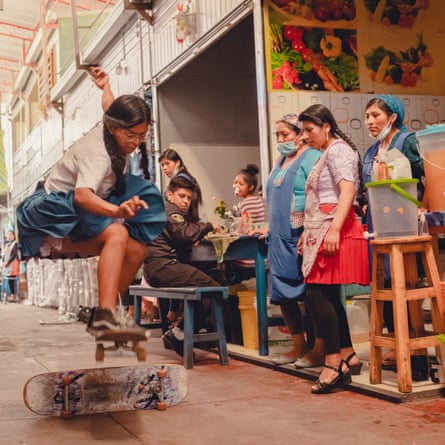
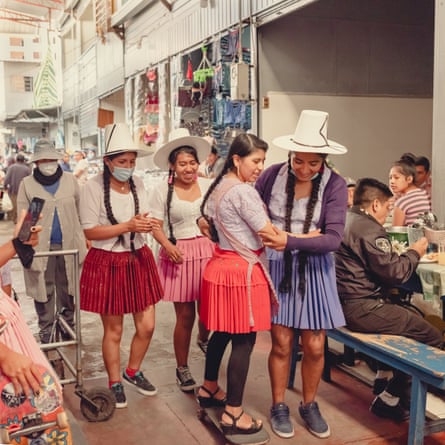
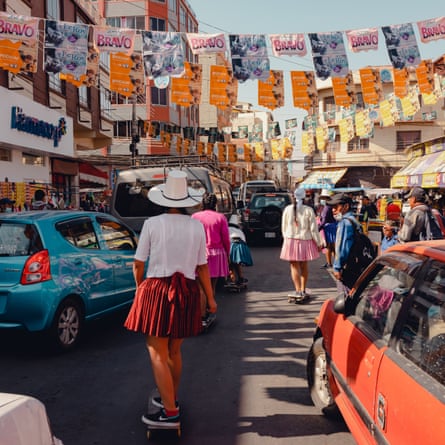

La Cancha Market in Cochabamba, Bolivia’s fourth largest city
Visiting La Cancha Market is almost an anthropological experience, considering that it is one of the most popular markets in Latin America. There you can find anything from basic food supplies to regional food, books, clothing, handcrafts, antiques, and even the most updated electronics – as well as a lot of piracy. “It’s not only about wearing the pollera outfit, it’s also about getting better in the sport, making new manoeuvres. We started as regular skateboarders – with time we had this idea about dressing up like cholitas because it identifies us. Nowadays it is a fusion of both things. Skateboarding for me is about progress in my life” says Deysi.

ImillaSkate visiting Misk’í Ñawisita store for the first time

This store is considered by them to have the most beautiful clothing in town. Some outfits can cost around $200 (£148). Belu says that in the beginning she was surprised by the variety of colours and models of the blouses and pollera skirts. She was struck by the details of the accessories, which are pieces that highlight the beauty of women from Cochabamba. “I got touched by the radical change of stronger colours, I felt like an empowered woman with the will power to go out and shine, proud of wearing a pollera,” says Belu.

Skating at the Pairumani park entrance
One of the girls’ preferred spots for skateboarding for its beauty is a little downhill located in Quillacollo on a road that leads to the Ecotourism Park of Pairumani, in the outskirts of Cochabamba. “We have a wide variety of plants and trees here, that’s why Cochabamba is called Ciudad Jardín, which translates as Garden City,” says Dani. ImillaSkate wanted to share places that represent their town and the nature that is always present. The road is filled with iconic trees from Cochabamba’s flora and it is also the area of plantation fields that are responsible for many agricultural workplaces for many people in the community.

Huara Medina Montaño (24) at La Minirampa
La Minirampa is a private space that was made by some friends from the old-school skate movement in Cochabamba. Since this is a self-financed project and requires maintenance, there’s a voluntary contribution to skate there and also to help with the rent payment. “ImillaSkate was introduced to this place by friends and we skate there every now and then since it’s not always open, but it’s an amazing place to be with close friends and have a great session.”


Huara getting ready to practise at La Minirampa, a private space for skaters in Cochabamba. Right – Huara at Ollantay Park
Hairstyle is part of their cultural identity. They make it as a ritual that is a big part of their personal care and also a moment where they can dedicate some time for themselves. While they brush their long hair, they cleanse themselves from bad energies and brushing each others hair is also a way to keep a strong connection between them.

Skaters at Ollantay Park
Built in 2019, as an initiative from the skate movement in Cochabamba and “proyecto mARTadero”. It’s located in La Coronilla, an with a high crime rate, and the park was built there to renew and appropriate the public space that before was used as an illegal parking lot for buses. It was a really neglected. ImillaSkate has been using the space even before its inauguration, and they keep practising there every day they can as it’s a public space and not fenced off. ImillaSkate started skate lessons there as “OllantayWasi Escuelita de Skate” (Ollantay House skate school). It was mainly for the kids in the area but their little school has grown. “Ollantay is the first park dedicated only to skateboarding, and has other areas for breakdancing and parkour, and also a sports field.”

Daniela Nicole Santiváñez Limache, 25. Dani was introduced to the skate world by her brother when she was a child
“We are no different, we all are indigenous descendants”, says Santiváñez referring to the nine women who are currently part of the group. They don’t wear the polleras on a day-to-day basis, but only for skating. Knee-length and paired with sneakers, as was the case in the past, the polleras adapted again and became a symbol. The Imillas, who practise to compete in local tournaments, use this presence and their skateboards as a natural vehicle to empower women and push their message of inclusion and acceptance of diversity.

Deysi Tacuri Lopez (27)
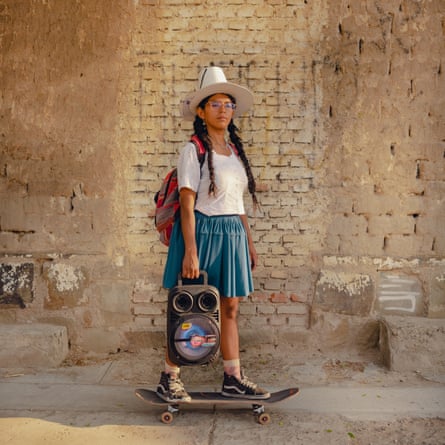
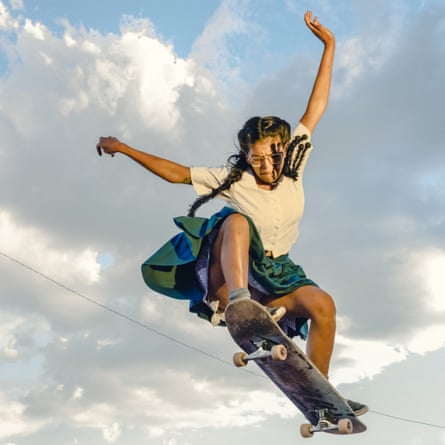
Deysi started skateboarding at about 20 years old. Even though she had hard falls, she decided to continue practising anyway. She says that skateboarding is an inner happiness for her, not only a sport but an activity that changed her lifestyle and helps her everyday with her struggles. She regards the pollera as an authentic and unique expression of her4 identity. “I wear what I like. My mother has a saying – I was born wearing a pollera and I will die wearing one – and I carry on her belief. I feel comfortable as I am, wearing a pollera.” Deyse has the intention to popularise the skate culture in Bolivia, creating more opportunities for the new generation without losing the focus on their roots. “It’s not only about wearing the pollera outfit, it’s also about getting better in the sport, making new manoeuvres. We started as regular skateboarders, with time we had this idea about dressing up like cholitas because it identifies us, nowadays it is a fusion of both things. Skateboarding for me is about progress in my life” says Deysi. Deysi won several medals in Chile and Bolivia, some for first place.

Brenda and Deysi (with cat)
Pollera women give an extra importance to their hair as you will most likely never see a cholita with no hair. All of them have long and well-treated hair as it is a must to have beautiful braids,” explains Brenda. For Brenda, brushing it is a way to get rid of sadness as her grandmother used to do it when she wanted to feel good again.

Joselin Brenda Mamani tinta (27) and Lucia Rosmeri tinta Quispe (46)
Brenda started skateboarding six years ago and felt it could give her direction, something to learn that would stimulate her to drop her fears and get out of her comfort zone. She says: “It makes me feel capable because I can break my own limits and I can dare to do things that I have never thought about, and like this I can get over my daily fear.” For her, skateboarding in pollera outfits means a challenge by itself because it is very hard to skateboard wearing a voluminous skirt but she knows that perseverance and practise will help and she has been improving her skills. For her this activity represents her roots, the place she comes from and who she is.

Huara teaching Deys’s mother
“I felt … skateboarding influenced my life a lot, it filled me with courage when I needed it most. And it is something that I would like to be able to share with other people, and that they can feel it even for a moment,” says Huara.

Luisa Zurita wearing her grandmother’s pollera
Luisa’s grandmother was raised in the pollera culture. She had seven children, five girls and two boys. Her mother and her aunts didn’t wear the polleras as part of their upbringing. In 2016, Luisa started skateboarding but her family didn’t approve of her passion for the sport and forbade her from practising. She had to fight her own family to be able to continue. ImillaSkate were invited to appear on a local popular TV show, which was when her grandmother found out that she continued practising. Finally, after the TV show appearance, her grandmother gave her the blessing to follow her dream and passed on to her one of her favorite polleras, the one she chose to wear to skateboard.
